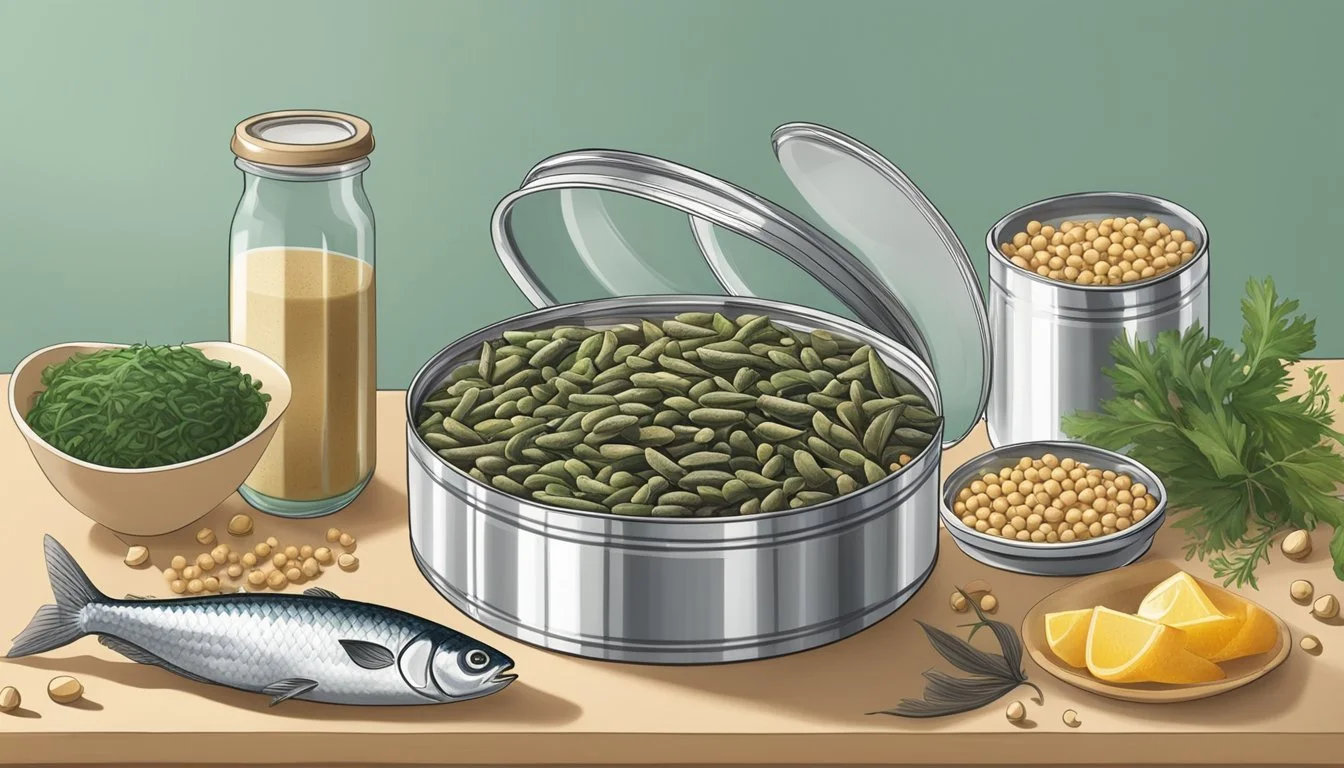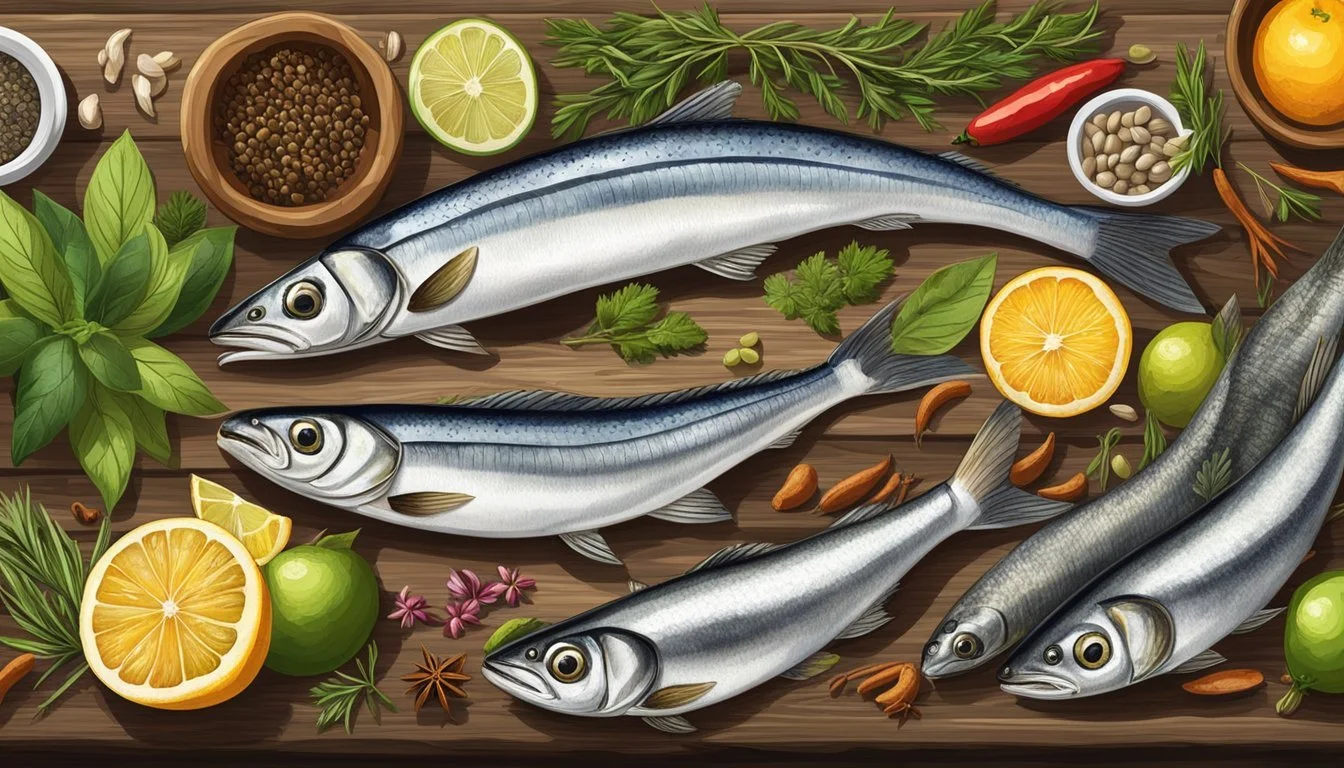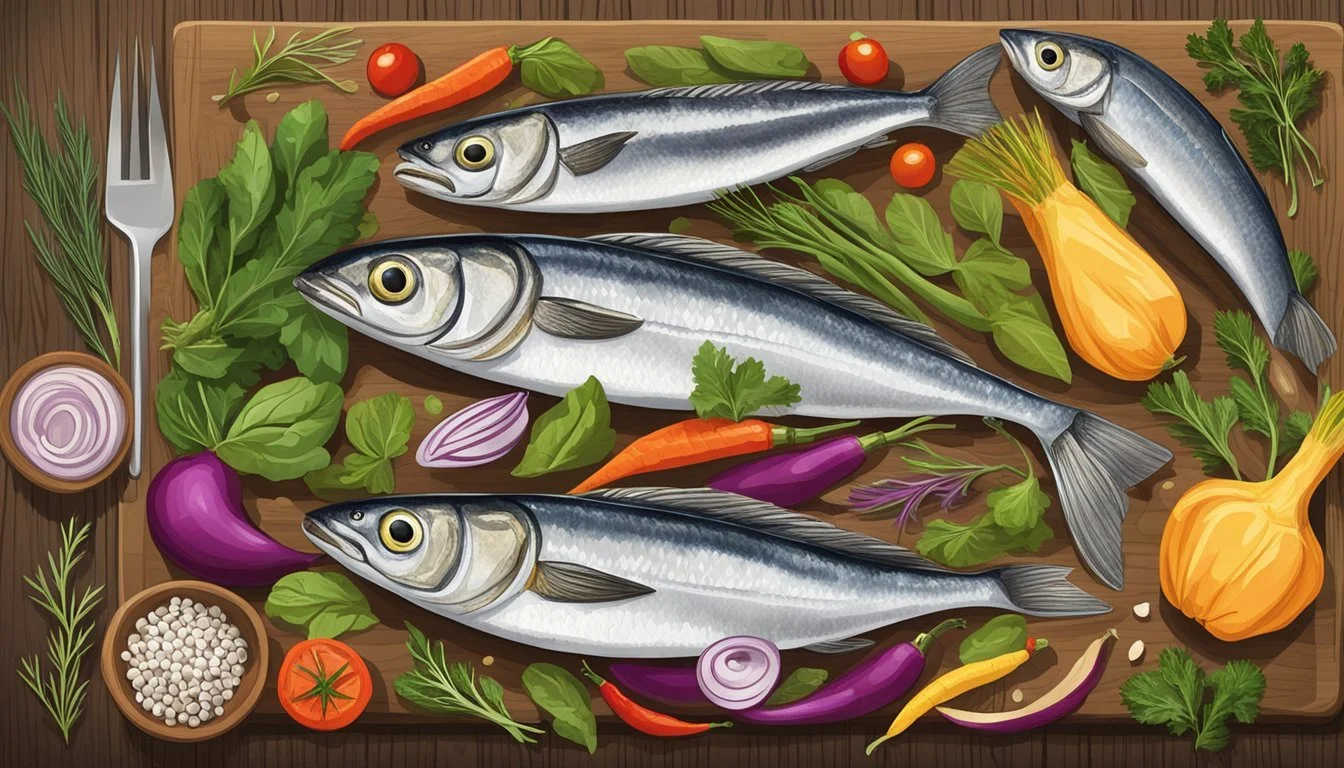Sardines Substitutes
Top Alternatives for Your Recipes
Finding the right substitute for sardines in your recipes can elevate your culinary experience without sacrificing flavor or texture. Whether you are seeking alternatives for dietary restrictions or simply want to try something new, numerous options deliver satisfying results. Anchovies, mackerel, and herring are excellent fish-based substitutes, each bringing their unique taste profiles to the table.
For those opting for plant-based alternatives, capers and Kalamata olives provide a salty, tangy substitute that works well in many dishes. These ingredients can mimic the umami richness sardines are known for, especially in Mediterranean recipes. Tangy hearts of palm also offer a vegetarian option, delivering a satisfying texture and flavor to your meals.
By exploring these substitutes, one can not only find a suitable replacement for sardines but also discover new and exciting flavors that enhance any dish.
Understanding Sardines
Sardines are small, oily fish that belong to the herring family. These fish are rich in omega-3 fatty acids, which are essential for cardiovascular health.
They are a significant source of vitamins and minerals, including Vitamin B12, Vitamin D, calcium, and selenium. These nutrients contribute to energy production, bone health, and immune function.
Nutritional Benefits
Nutrient Benefit Omega-3 Fatty Acids Heart health, anti-inflammatory effects Vitamin B12 Red blood cell formation, brain function Calcium Bone strength Selenium Antioxidant properties
Sardines can be found in various oceans around the world. They are particularly abundant in the Atlantic and Pacific Oceans. These fish have been a staple in Mediterranean diets for centuries.
The small size of sardines makes them easy to eat whole, with bones, skin, and all, providing a substantial amount of dietary calcium. Because they are oily, they have a distinct, rich flavor that can enhance many recipes.
Sardines are often preserved in oil, water, or sauces, making them convenient for a variety of culinary uses. From grilled and baked to canned varieties, their versatility is unmatched.
In summary, sardines not only offer diverse nutritional benefits but also boast a rich history and wide culinary application. This makes them an invaluable addition to any diet.
Nutritional Profile of Sardines
Sardines offer an impressive nutritional profile, making them a valuable addition to a balanced diet.
They are rich in omega-3 fatty acids, which support heart health and reduce inflammation.
A 3-ounce serving typically provides:
Omega-3 Fatty Acids: 1,000-1,800 mg
Protein: 20-25 grams
Calories: Approximately 180-200
Sardines are also an excellent source of calcium and vitamin D. A 3-ounce serving with bones can provide around 32% of the daily calcium requirement.
Other notable nutrients:
Vitamin B12: Essential for brain function
Selenium: Important for antioxidant protection
Vitamin E: Supports skin and immune health
Sardines do not contain oxalic acid, enhancing calcium absorption.
Incorporating sardines into meals can boost overall nutrient intake, promoting overall health.
Why Substitute Sardines?
Sardine substitutes are often sought due to dietary restrictions, availability, and personal preferences. Understanding these reasons can help ensure that meals remain both enjoyable and compliant with individual needs.
Dietary Restrictions
Many people substitute sardines due to dietary restrictions. For those following a vegetarian or vegan diet, sardines are not an option. Plant-based alternatives such as capers or hearts of palm can offer similar salty and tangy flavors without compromising dietary choices.
Additionally, some might avoid sardines due to allergies or intolerances. In these cases, choosing substitutes like mackerel or herring can be suitable, as they offer rich taste and texture without the allergenic components found in sardines.
Availability And Personal Preference
Sometimes sardines may not be readily available in certain regions. Local markets might not stock them regularly, making it necessary to find substitutes. Fish like anchovies and mackerel are often more widely accessible and can serve as suitable replacements, though they have different flavor profiles.
Personal preference plays a significant role, too. Not everyone enjoys the flavor or texture of sardines. In such cases, selecting options such as anchovies for a more intense taste or herring for a similarly oily and flaky experience can help maintain the desired culinary result without compromising on the dish's quality.
Culinary Uses of Sardine Substitutes
Sardine substitutes, such as capers, miso paste, and hearts of palm, bring unique flavors and textures to various dishes. Each substitute has its own application in Mediterranean classics, Southeast Asian dishes, salads and appetizers, and pasta and pizzas.
Mediterranean Classics
Capers and kalamata olives are excellent plant-based options for replacing sardines in Mediterranean recipes. These ingredients offer a salty and tangy flavor, making them ideal for dishes like puttanesca sauce and tapenade. Capers, with their small and pickled nature, add a punch of taste to meals, while olives provide a robust flavor profile.
Another substitute is miso paste, which, though not Mediterranean in origin, can offer a similar umami depth to dishes like marinated grilled vegetables or bean salads. Adding these substitutes preserves the authentic Mediterranean feel, enhancing recipes without losing the essence of the cuisine.
Southeast Asian Dishes
Soy sauce and miso paste work well in Southeast Asian recipes. Soy sauce, known for its deep umami flavor, can replace sardines in soups, stir-fries, and marinades, adding a savory depth to the dishes. Miso paste also brings umami richness and can be used in broths and dressings.
Additionally, fish sauce is another substitute that aligns more closely with Southeast Asian tastes, offering the fishy, salty notes commonly found in the region's cuisine. These substitutes fit seamlessly into recipes, preserving the intricate flavors that define Southeast Asian culinary traditions.
Salads and Appetizers
For refreshing salads and appetizers, hearts of palm and capers make ideal substitutes for sardines. Hearts of palm provide a light, slightly tangy flavor, making them suitable for vegetarian dishes. Their texture mimics the firmness of sardines, and they work well in green salads or as garnishes.
Capers bring a briny burst of flavor to dishes like potato salads or avocado toast, adding complexity and taste. Miso paste can also be mixed into dressings, providing a savory element that enhances the overall flavor profile of salads and appetizers.
Pasta and Pizzas
Kalamata olives and miso paste are perfect for pasta and pizza dishes that traditionally include sardines. Kalamata olives add a salty and slightly bitter taste, complementing tomato-based sauces in pasta dishes like puttanesca or on pizza toppings.
Miso paste can create a rich, umami-packed sauce for pasta, similar to the depth sardines provide. Capers offer a delicious alternative when scattered on pizzas, providing bursts of salty flavor that cut through rich cheeses and sauces. These substitutes enhance the dishes without overwhelming other ingredients, maintaining a balanced taste experience.
Meaty Sardine Substitutes
For those seeking alternatives to sardines but still wanting a robust, meaty texture, there are several excellent choices. Both fish and plant-based substitutes offer a variety of flavors and textures to suit different culinary needs.
Fish Alternatives
Mackerel and herring are two popular fish substitutes for sardines. Both are oily fish with a rich, intense flavor and firm texture. Mackerel, with its high-fat content, offers a tender, juicy bite that works well in dishes like salads or sandwiches. Herring, on the other hand, has a slightly milder taste but still provides the necessary umami punch.
Another good option is tuna. While it lacks the fishy taste of sardines, it compensates with its robust, meaty flavor and firm texture, making it suitable for dishes like casseroles or pasta. Salmon can also be a substitute, especially for those looking for a milder flavor. Its soft texture and high-fat content make it versatile in various recipes, from wraps to salads.
Plant-Based Meaty Options
For those following a vegan diet, tempeh and tofu are excellent plant-based alternatives to sardines. Tempeh, made from fermented soybeans, has a firm texture and a nutty, savory flavor, making it an ideal substitute in dishes requiring a meaty bite. It can be marinated and baked to enhance its taste.
Tofu, while softer than tempeh, absorbs flavors well and can be pan-fried or grilled to achieve a firmer texture. Kalamata olives and capers also provide a chewy, meaty texture. They bring a burst of umami flavor, which can complement various dishes, such as salads or pastas. These options offer a satisfying alternative to fish for those seeking plant-based choices.
Focus on Flavor
Choosing the right substitute for sardines involves understanding the varied flavors they bring to a dish. Different substitutes can provide savory, salty, and briny characteristics.
Savory and Umami
Sardines are known for their rich, savory, and umami taste, making them a favored ingredient in many recipes. A good substitute to achieve this depth of flavor is anchovies. Anchovies deliver a potent umami kick and can be used sparingly due to their intense taste.
Anchovy paste is another option for adding umami without the texture of whole anchovies. Mackerel, with its similar fat content and rich taste, also works well in recipes where a robust savory flavor is desired.
Salty and Pungent
The salty and sometimes pungent taste of sardines can be mimicked using capers. Capers are pickled flower buds that introduce a punchy, salty, and tangy flavor to dishes. They are especially effective in Mediterranean-inspired recipes, which often call for that specific flavor profile.
Kalamata olives can also serve as a substitute, bringing a chewy texture and a burst of salty umami flavor. The earthy undertones of these olives can add complexity similar to that provided by sardines.
Briny and Acidic Notes
For those seeking the briny and acidic notes found in sardines, options like lemon juice and hearts of palm can be effective. Lemon juice provides acidity and a fresh citrus tang that cuts through other flavors, brightening the dish. Combined with another substitute, it can replicate the acidic balance sardines offer.
Hearts of palm have a briny flavor and a unique texture suitable for plant-based diets, mimicking the feel of sardines without the fishy taste. These can be used in salads and other recipes where a lighter, yet briny component is desired.
Vegetarian and Vegan Substitutes
Vegetarian and vegan substitutes for sardines can impart similar umami flavors and textures to dishes. Several options exist, ranging from soy products to nutritional yeast and various seaweed varieties.
Miso and Soy Products
Miso and soy products offer rich flavors that can closely mimic the umami taste of sardines. Miso paste, made from fermented soybeans, brings a salty and savory profile to dishes. It can be used in soups, stews, and sauces to enhance depth.
Soy sauce and tamari serve as excellent liquid alternatives, providing a robust, salty flavor that can stand in for the fishy essence of sardines. Soy products are versatile and widely available, making them an accessible choice for many home cooks.
Nutritional Yeast and Vegan Condiments
Nutritional yeast serves as a popular vegetarian alternative, providing a cheesy, nutty taste that can elevate various dishes. It is often used in vegan cuisine to replace cheese and can offer a similar depth to sardines in pasta sauces or casserole dishes.
Vegan condiments like veganase or vegan Worcestershire sauce also come in handy. Vegan Worcestershire sauce for instance, can mimic the tangy, savory qualities of traditional Worcestershire that often contains anchovies, making it suitable for vegetarian diets.
Seaweed Varieties
Seaweed varieties such as nori and kelp bring natural ocean flavors that can be used to replicate the taste of sardines in vegetarian and vegan recipes.
Nori sheets, commonly used in sushi, can be ground and added to dishes for a sea-like flavor. Kelp, available in powdered or dried forms, can also add a salty, umami-rich profile to soups and salads.
These seaweeds are versatile and quite potent, often requiring minimal quantities to achieve the desired flavor. They are particularly useful in Mediterranean or Asian-inspired recipes where a touch of sea essence is desired.
Taste Enhancers and Aromatics
Achieving the desired flavor profile in sardine substitutes can be greatly influenced by the strategic use of taste enhancers and aromatics. These elements can mimic the essence of sardines, providing richness and depth to dishes.
Herbs and Spices
Herbs and spices play a crucial role in infusing dishes with the desired flavors. Dill and oregano are excellent choices; dill offers a fresh, slightly tangy profile, while oregano contributes a robust, earthy aroma. Garlic and onion are essential for creating a base layer of flavor, either minced or roasted, adding complexity to various dishes.
Marinades incorporating these aromatics help in enhancing the substitutes' flavor. Adding a touch of paprika or cumin can emulate the smoky flavor of sardines, providing an additional layer of depth.
Oils and Acids
Oils and acids are indispensable in mimicking the rich, oily texture of sardines. Olive oil is particularly effective due to its fruity and slightly peppery notes. It not only adds flavor but also aids in the blending of other ingredients. For a Mediterranean twist, olive oil can be infused with herbs like rosemary or thyme.
Acids like lemon juice and vinegar bring a necessary tang, balancing the richness of the oil. These acidic elements can brighten the dish, making it feel lighter and more vibrant. Incorporating a tapenade made from olives and capers can also introduce a briny, umami flavor, replicating the taste profile of sardines in dips and spreads.
Preparing Substitutes
This section provides techniques for cooking substitutes for sardines and adapting recipes to ensure the substitutes integrate seamlessly. It covers methods to retain or enhance the essence of traditional dishes that typically use sardines.
Cooking Techniques
When using substitutes for sardines like mackerel, herring, or anchovies, it's essential to adjust the cooking methods. Mackerel, with its rich taste and similar fat content, can be grilled or broiled just like sardines. Herring, being flaky and oily, works well in dishes that require slow cooking such as stews and soups.
Anchovies melt into sauces, adding umami and salinity. When substituting anchovies, the key is to cook them gently in olive oil until they dissolve. Use anchovies sparingly due to their intense flavor.
For plant-based alternatives, Kalamata olives should be added toward the end of cooking to prevent over-softening. Similarly, capers can be lightly sautéed to release their flavors without diminishing their unique taste.
Recipe Adaptation
Adapting recipes like Caesar salad dressing and pasta puttanesca to use substitutes requires attention to flavor balance. When using anchovies in place of sardines in Caesar salad dressing, account for increased saltiness by adjusting other salty ingredients.
In pasta puttanesca, where sardines provide a meaty texture, anchovies or capers add depth. Reduce the quantity of added salt when using salt-packed anchovies.
For soups and stews, replace sardines with mackerel or herring, adjusting the cooking time to ensure the fish is tender without falling apart. Adding capers or olives can enhance Mediterranean-styled recipes, providing a flavorful and appealing substitute.
Enhancing marinara sauce with substitutes like herring or Kalamata olives introduces an earthy umami flavor, making the sauce robust. Ensure that the substitutes are added at the right stage to maintain texture and taste. Focus on maintaining the essence of the original dish while accommodating the flavor of the substitute.
Availability and Storage
Sardines are commonly available in various forms, including fresh, canned, and frozen. Canned sardines are particularly popular due to their long shelf life and convenience. They can be found in most supermarkets and come packed in water, oil, or tomato sauce.
Fresh sardines can sometimes be found at fish markets or specialized grocery stores. They should be bought when they are bright-eyed and firm to the touch.
Storage of Sardines:
For fresh sardines: Clean them, pat dry, and store in a shallow glass or plastic container covered with oil. Ensure the container is airtight and kept below 40°F (4°C) to prevent spoilage.
For canned sardines: Store in a cool, dry place. Once opened, any unused portion should be transferred to an airtight container and refrigerated.
Keeping dried goods such as dried mushrooms alongside your sardines can add versatility to your recipes. Both items do not require refrigeration and can be stored in a pantry.
Understanding the availability and proper storage techniques ensures the optimal quality and taste of sardines, making them a valuable addition to various dishes.
Creative Substitution Ideas
For those seeking alternatives to sardines, there are innovative and flavorful options suitable for both vegan and omnivorous diets. These substitutes are particularly effective in enhancing dishes like Caesar salads and pizzas.
Vegan Caesar Salad Twists
Capers are an excellent plant-based substitute for sardines in a Caesar salad. These small, pickled flower buds provide a salty, tangy flavor that mimics the briny taste of fish without the use of animal products. They are especially compatible with Mediterranean-inspired recipes.
Kalamata olives offer a burst of salty umami flavor and a meaty texture. Their intense flavor makes them a suitable alternative in dressings or as a topping.
Hearts of Palm add a unique, fibrous texture that complements the creamy dressing of a Caesar salad. Sliced thin, they blend well with classic Caesar ingredients like Romaine lettuce and vegan Parmesan.
Innovative Pizza Toppings
Mackerel can be a fantastic substitute, offering a rich, oily taste similar to sardines. It pairs well with tomato-based sauces and holds up under the high heat of a pizza oven.
Red pepper flakes combined with vegan cream cheese and fennel create a spicy and creamy topping. The combination of these ingredients provides a complex flavor profile that elevates the overall taste of the pizza.
Anchovies bring a robust flavor to pizzas. When used sparingly, they add a deeply savory component that enhances the other ingredients.
Veganaise mixed with chopped olives and capers can be spread as a base layer on the dough. This mix brings a creamy and tangy note that pairs well with fresh vegetables and herbs.
By leveraging these creative substitution ideas, one can enjoy the essence of sardines in a variety of dishes without compromising on flavor or texture.











